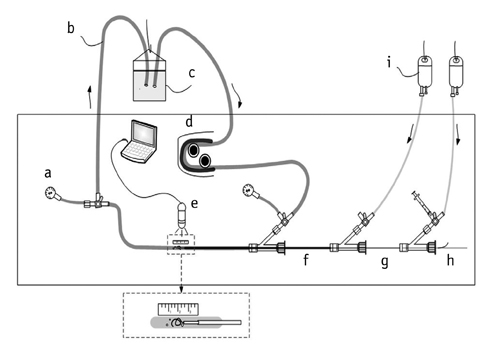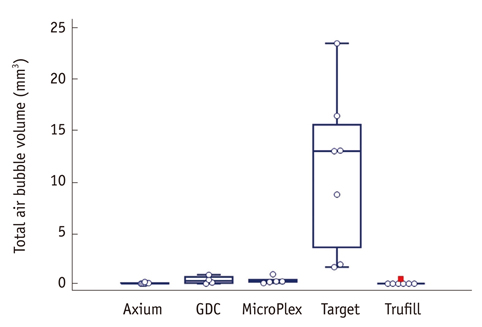Korean J Radiol.
2012 Aug;13(4):412-416. 10.3348/kjr.2012.13.4.412.
In Vitro Observation of Air Bubbles during Delivery of Various Detachable Aneurysm Embolization Coils
- Affiliations
-
- 1Department of Radiology, Research Institute of Radiology, Asan Medical Center, University of Ulsan College of Medicine, Seoul 138-736, Korea. dhlee@amc.seoul.kr
- 2Department of Radiology, Chung-Ang University College of Medicine, Seoul 156-861, Korea.
- KMID: 1383852
- DOI: http://doi.org/10.3348/kjr.2012.13.4.412
Abstract
OBJECTIVE
Device- or technique-related air embolism is a drawback of various neuro-endovascular procedures. Detachable aneurysm embolization coils can be sources of such air bubbles. We therefore assessed the formation of air bubbles during in vitro delivery of various detachable coils.
MATERIALS AND METHODS
A closed circuit simulating a typical endovascular coiling procedure was primed with saline solution degassed by a sonification device. Thirty commercially available detachable coils (7 Axium, 4 GDCs, 5 MicroPlex, 7 Target, and 7 Trufill coils) were tested by using the standard coil flushing and delivery techniques suggested by each manufacturer. The emergence of any air bubbles was monitored with a digital microscope and the images were captured to measure total volumes of air bubbles during coil insertion and detachment and after coil pusher removal.
RESULTS
Air bubbles were seen during insertion or removal of 23 of 30 coils (76.7%), with volumes ranging from 0 to 23.42 mm3 (median: 0.16 mm3). Air bubbles were observed most frequently after removal of the coil pusher. Significantly larger amounts of air bubbles were observed in Target coils.
CONCLUSION
Variable volumes of air bubbles are observed while delivering detachable embolization coils, particularly after removal of the coil pusher and especially with Target coils.
MeSH Terms
Figure
Cited by 1 articles
-
Thromboembolic Events Associated with Electrolytic Detachment of Guglielmi Detachable Coils and Target Coils : Comparison with Use of Diffusion-Weighted MR Imaging
Myeong Jin Kim, Yong Cheol Lim, Se-yang Oh, Byung Moon Kim, Bum-soo Kim, Yong Sam Shin
J Korean Neurosurg Soc. 2013;54(1):19-24. doi: 10.3340/jkns.2013.54.1.19.
Reference
-
1. Dunn GD. Microscopic air embolism and cerebral angiography. Lancet. 1993. 341:1215–1216.2. Markus H. Transcranial Doppler detection of circulating cerebral emboli. A review. Stroke. 1993. 24:1246–1250.3. Bendszus M, Koltzenburg M, Burger R, Warmuth-Metz M, Hofmann E, Solymosi L. Silent embolism in diagnostic cerebral angiography and neurointerventional procedures: a prospective study. Lancet. 1999. 354:1594–1597.4. Heiserman JE. Silent embolism after cerebral angiography--what harm? Lancet. 1999. 354:1577–1578.5. Sayama T, Mitani M, Inamura T, Yagi H, Fukui M. Normal diffusion-weighted imaging in cerebral air embolism complicating angiography. Neuroradiology. 2000. 42:192–194.6. Chuah KC, Stuckey SL, Berman IG. Silent embolism in diagnostic cerebral angiography: detection with diffusion-weighted imaging. Australas Radiol. 2004. 48:133–138.7. Gupta R, Vora N, Thomas A, Crammond D, Roth R, Jovin T, et al. Symptomatic cerebral air embolism during neuro-angiographic procedures: incidence and problem avoidance. Neurocrit Care. 2007. 7:241–246.8. Mamourian AC, Weglarz M, Dunn J, Cromwell LD, Saykin AJ. Injection of air bubbles during flushing of angiocatheters: an in vitro trial of conventional hardware and techniques. AJNR Am J Neuroradiol. 2001. 22:709–712.9. Markus H, Loh A, Israel D, Buckenham T, Clifton A, Brown MM. Microscopic air embolism during cerebral angiography and strategies for its avoidance. Lancet. 1993. 341:784–787.10. Bendszus M, Koltzenburg M, Bartsch AJ, Goldbrunner R, Günthner-Lengsfeld T, Weilbach FX, et al. Heparin and air filters reduce embolic events caused by intra-arterial cerebral angiography: a prospective, randomized trial. Circulation. 2004. 110:2210–2215.11. Derdeyn CP. Diffusion-weighted imaging as a surrogate marker for stroke as a complication of cerebrovascular procedures and devices. AJNR Am J Neuroradiol. 2001. 22:1234–1235.12. Soeda A, Sakai N, Murao K, Sakai H, Ihara K, Yamada N, et al. Thromboembolic events associated with Guglielmi detachable coil embolization with use of diffusion-weighted MR imaging. Part II. Detection of the microemboli proximal to cerebral aneurysm. AJNR Am J Neuroradiol. 2003. 24:2035–2038.13. Kim SJ, Roh HG, Jeon P, Kim KH, Lee KH, Byun HS, et al. Cerebral ischemia detected with diffusion-weighted MR imaging after protected carotid artery stenting: comparison of distal balloon and filter device. Korean J Radiol. 2007. 8:276–285.14. Chung SW, Baik SK, Kim Y, Park J. Thromboembolic events after coil embolization of cerebral aneurysms: prospective study with diffusion-weighted magnetic resonance imaging follow-up. J Korean Neurosurg Soc. 2008. 43:275–280.15. Helps SC, Meyer-Witting M, Reilly PL, Gorman DF. Increasing doses of intracarotid air and cerebral blood flow in rabbits. Stroke. 1990. 21:1340–1345.16. Helps SC, Parsons DW, Reilly PL, Gorman DF. The effect of gas emboli on rabbit cerebral blood flow. Stroke. 1990. 21:94–99.17. Muth CM, Shank ES. Gas embolism. N Engl J Med. 2000. 342:476–482.18. Um SJ, Lee SK, Yang DK, Son C, Kim KN, Lee KN, et al. Four cases of a cerebral air embolism complicating a percutaneous transthoracic needle biopsy. Korean J Radiol. 2009. 10:81–84.19. Menzel M, Doppenberg EM, Zauner A, Soukup J, Reinert MM, Bullock R. Increased inspired oxygen concentration as a factor in improved brain tissue oxygenation and tissue lactate levels after severe human head injury. J Neurosurg. 1999. 91:1–10.20. Goodman JC, Valadka AB, Gopinath SP, Uzura M, Robertson CS. Extracellular lactate and glucose alterations in the brain after head injury measured by microdialysis. Crit Care Med. 1999. 27:1965–1973.21. van Hulst RA, Lameris TW, Hasan D, Klein J, Lachmann B. Effects of cerebral air embolism on brain metabolism in pigs. Acta Neurol Scand. 2003. 108:118–124.22. Hossmann KA. Experimental models for the investigation of brain ischemia. Cardiovasc Res. 1998. 39:106–120.23. Annane D, Troché G, Delisle F, Devauchelle P, Hassine D, Paraire F, et al. Kinetics of elimination and acute consequences of cerebral air embolism. J Neuroimaging. 1995. 5:183–189.24. Han MH, Kwon OK, Yoon CJ, Kwon BJ, Cha SH, Chang KH. Gas generation and clot formation during electrolytic detachment of Guglielmi detachable coils: in vitro observations and animal experiment. AJNR Am J Neuroradiol. 2003. 24:539–544.
- Full Text Links
- Actions
-
Cited
- CITED
-
- Close
- Share
- Similar articles
-
- Endovascular Treatment of Cerebral Aneurysm with Mechanical Dtachable System-Spiral Coils
- Endovascular Coil Trapping of a Ruptured Dissecting Aneurysm of the Vertebral Artery Using Detachable Coils and Micro-Tornado(R) Coils
- Persistent Trigeminal Artery Aneurysm Treated with Guglielmi Detachable Coils
- Endovascular Treatment of Cerebral Aneurysms: Detachable Coils and General Principles
- Thromboembolic Events Associated with Electrolytic Detachment of Guglielmi Detachable Coils and Target Coils : Comparison with Use of Diffusion-Weighted MR Imaging





